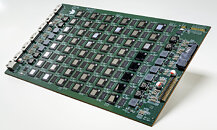TheLostSwede
News Editor
- Joined
- Nov 11, 2004
- Messages
- 16,193 (2.27/day)
- Location
- Sweden
| System Name | Overlord Mk MLI |
|---|---|
| Processor | AMD Ryzen 7 7800X3D |
| Motherboard | Gigabyte X670E Aorus Master |
| Cooling | Noctua NH-D15 SE with offsets |
| Memory | 32GB Team T-Create Expert DDR5 6000 MHz @ CL30-34-34-68 |
| Video Card(s) | Gainward GeForce RTX 4080 Phantom GS |
| Storage | 1TB Solidigm P44 Pro, 2 TB Corsair MP600 Pro, 2TB Kingston KC3000 |
| Display(s) | Acer XV272K LVbmiipruzx 4K@160Hz |
| Case | Fractal Design Torrent Compact |
| Audio Device(s) | Corsair Virtuoso SE |
| Power Supply | be quiet! Pure Power 12 M 850 W |
| Mouse | Logitech G502 Lightspeed |
| Keyboard | Corsair K70 Max |
| Software | Windows 10 Pro |
| Benchmark Scores | https://valid.x86.fr/yfsd9w |
Today, in advance of ISC High Performance 2024, SpiNNcloud Systems announced the commercial availability of its SpiNNaker2 platform, a supercomputer-level hybrid AI high-performance computer system based on principles of the human brain. Pioneered by Steve Furber, designer of the original ARM and SpiNNaker1 architectures, the SpiNNaker2 supercomputing platform uses a large number of low-power processors for efficiently computing AI and other workloads.
First-generation SpiNNaker1 architecture is currently used in dozens of research groups across 23 countries worldwide. Sandia National Laboratories, Technical University of München and Universität Göttingen are among the first customers placing orders for SpiNNaker2, which was developed around commercialized IP invented in the Human Brain Project, a billion-euro research project funded by the European Union to design intelligent, efficient artificial systems.

"Brain-like computation requires programmable dynamics, event-based communication, and extreme scale," said Fred Rothganger from Sandia National Labs. "SpiNNaker2 is the most flexible neural supercomputer architecture available today. At Sandia, we are excited to build applications on this amazing system."
Technical specifications for SpiNNaker2 include:
"Our vision is to pioneer the future of artificial intelligence through brain-inspired supercomputer technology, and to create systems that are not only powerful but also transparent and explainable," said Hector Gonzalez, co-founder and co-CEO at SpiNNcloud Systems. "We're building the most advanced brain-like supercomputing platform on the market, which positions us as the market leader in hybrid AI HPC. And it enables us to drive the development of reliable, efficient hybrid AI systems, opening up entirely new markets in next-generation defense, drug discovery, quantum emulation, smart city applications and more."
The company's cloud service will be available in the second half of 2024, and full production systems will be available for shipment in the first half of 2025.
View at TechPowerUp Main Site | Source
First-generation SpiNNaker1 architecture is currently used in dozens of research groups across 23 countries worldwide. Sandia National Laboratories, Technical University of München and Universität Göttingen are among the first customers placing orders for SpiNNaker2, which was developed around commercialized IP invented in the Human Brain Project, a billion-euro research project funded by the European Union to design intelligent, efficient artificial systems.

"Brain-like computation requires programmable dynamics, event-based communication, and extreme scale," said Fred Rothganger from Sandia National Labs. "SpiNNaker2 is the most flexible neural supercomputer architecture available today. At Sandia, we are excited to build applications on this amazing system."
Technical specifications for SpiNNaker2 include:
- The SpiNNcloud server board consists of 48 SpiNNaker2 chips. Each chip contains a low-power mesh of 152 Arm-based cores with a wide variety of accelerators including distributed GPU-like units designed to boost neuromorphic, hybrid, and mainstream AI model computations.
- The hybrid capabilities of SpiNNaker2 allow it to combine practical algorithms from Machine Learning, energy efficiency from an event-based operation, and the trustworthiness of rule-based layers governing the backend of applications.
- The commercial system is intended to be scaled up through a multi-rack setup, each composed of 90 SpiNNcloud server boards to enable at least 10 billion interconnected neurons firing in real-time. As a supercomputer designed to also allocate Machine Learning workloads, the pre-exascale system can support up to 0.3 exaops.
- SpiNNaker2 differentiates from GPU solutions by being more versatile, having a better performance, having a lower cost to run and having a better availability.
- In contrast to GPU solutions, SpiNNaker2 uses a large number of asynchronous low-power units to tackle workloads. This leads to more versatility, energy-proportional operation, efficient communication, and lower operation cost. SpiNNcloud is the first to make this neuromorphic supercomputing architecture broadly available and at scales that exceed any other neuromorphic system.
- SpiNNaker2 goes beyond neuromorphic architecture by offering hybrid AI acceleration, crucial for designing systems "in the third wave of AI," defined by DARPA as systems that understand the context and environment in which they operate, and over time build underlying explanatory models that allow them to characterize real-world phenomena.
- SpiNNaker2 will be initially available as a cloud platform solution, enabling early customers to get access to the technology as cost efficiently as possible.
"Our vision is to pioneer the future of artificial intelligence through brain-inspired supercomputer technology, and to create systems that are not only powerful but also transparent and explainable," said Hector Gonzalez, co-founder and co-CEO at SpiNNcloud Systems. "We're building the most advanced brain-like supercomputing platform on the market, which positions us as the market leader in hybrid AI HPC. And it enables us to drive the development of reliable, efficient hybrid AI systems, opening up entirely new markets in next-generation defense, drug discovery, quantum emulation, smart city applications and more."
The company's cloud service will be available in the second half of 2024, and full production systems will be available for shipment in the first half of 2025.
View at TechPowerUp Main Site | Source



